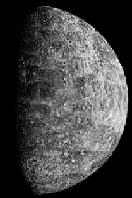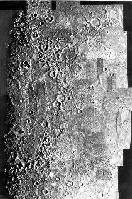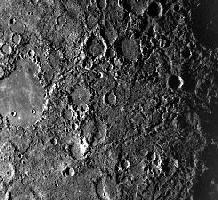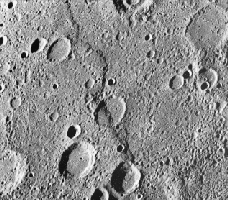The Surface and
Interior of Mercury
Speaking loosely, we may characterize
Mercury as being much like the Earth on the
inside and much like the Moon on the outside. However, the analogies cannot
be pushed too far. For example, the detailed early history of the surface was
probably different for Mercury than for the Moon.
Interior Structure
As noted previously, the density of Mercury and the magnetic field suggest
geological differentiation and a large iron core. In the case of the Earth the
metallic core occupies about 16% of the interior by volume and in the case of
the Moon the core occupies about 4% by volume. In the case of Mercury the core
is thought to occupy about 50% of the interior by volume (and a whopping 70% by
mass). Thus, Mercury is a planet with a very large iron core and a
comparatively thin mantle compared with the Earth.

Surface Features
There are three major types of surface features on Mercury:
- Smooth plains that resemble Lunar maria.
- Intercrater plains, which are pocked with small craters and occupy about
70% of the surface that we have examined.
- Rugged highlands that bear some resemblance to the corresponding regions on
the Moon.
The adjacent image shows a mosaic of photgraphs taken from Mariner 10 in 1974
that summarizes the character of the surface.
The following images illustrate three features from the surface of Mercury:
(1) a large impact basin that is similar to Mare Imbrium on the Moon, (2) the
highlands of Mercury, (3) and an example of a large geological fault.
There is no evidence for large-scale tectonic motion. It is believed that
plate tectonics requires differentiation of the interior, and a
large enough
volume to trap sufficient radioactive material to heat subsurface layers
and produce a plastic consistency below the crustal plates. Mercury is thought
to be too small for this to take place, thus explaining the lack of large-scale
tectonics.
A History of Mercury
Based on our present understanding of Mercury we may propose the following
planetary history:
- After formation the mass of the planet was differentiated into a large
iron core and thin mantle.
- Lava flowed outward through cracks in the mantle and formed the intercrater
plains. The oldest surfaces are about 4.2 billion years old.
- Solar tides slowed the rotation and formed large-scale linear features
(scarps and lines of cliffs) that we see today.
- The intense meteor bombardment characteristic of the early Solar System
caused cratering and produced large impact basins like the Caloris Basin.
- Starting about 3.8 billion years ago,
the smooth plains were created, possibly from volcanic activity triggered
by the earlier meteor impacts and erupting from the large impact basins.
- After the volcanic activity subsided, the planet has been very quiet
geologically except for the occasional meteor (however, it is probably
geologically more active than the Moon).
We see that this scenario shares some features with the corresponding history
of the Moon, but details, particularly early ones, are different. As a
consequence, the surface of Mercury looks superficially like the Moon, but
there are significant differences that appear upon closer inspection.



